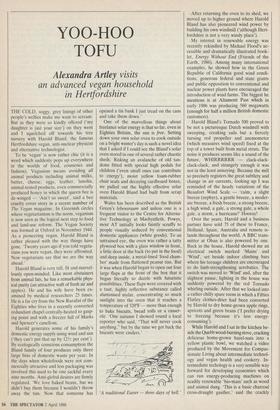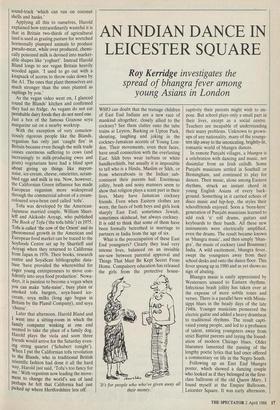YOO-HOO TOFU
Alexandra Artley visits an advanced vegan household in Hertfordshire
THE COLD, soggy, grey linings of other people's wellies make me want to scream. But as they were so kindly offered ('my daughter is just your size') on they went and I squelched off towards his tree nursery with Harold Bland, the famous Hertfordshire vegan, anti-nuclear physicist and alternative technologist.
To be 'vegan' is now rather chic (it is a word which suddenly pops up everywhere in the worlds of food, cosmetics and fashion). Veganism means avoiding all animal products including animal milks, butter, cheese, eggs, leather, lanolin, animal-tested products, even commercially produced honey in which the queen bee is de-winged — 'Ain't so sweet', said a bee cruelty cover story in a recent number of The Vegan magazine. In Greenish circles where vegetarianism is the norm, veganism is now seen as the logical next step to food and land-use reform. The Vegan Society was formed at Oxford in November 1944. As a pioneering vegan, Harold Bland is rather pleased with the way things have gone. 'Twenty years ago if you told vegeta- rians you were vegan, they were affronted. Now vegetarians say that we are the way ahead.'
Harold Bland is very tall, fit and marvel- lously open-minded. Like most abstainers from animal fats, he has a remarkable phys- ical purity (an attractive waft of fresh air and apples). He and his wife have been ex- amined by medical researchers 25 times. He is a far cry from the New Ruralist of the Eighties who lives in a recently converted redundant chapel centrally-heated to gasp- ing point and with a freezer full of Marks and Spencer's canelloni.
Harold generates some of his family's domestic energy supply using wind and sun ('they can't put that up by 121/2 per cent'). By ecologically conscious consumption the Bland family of four produces only three large bins of domestic waste per year. In the days when wholefoods were not com- mercially attractive and less packaging was involved this used to be one sackful every nine months. Anti-global desires are firmly regulated. 'We love baked beans, but we didn't buy them because I wouldn't throw away the tins. Now that someone has opened a tin bank I just tread on the cans and take them down.'
One of the marvellous things about freelance solar energy is that so far, even in Eighties Britain, the sun is free. Setting down your own solar oven to cook outside on a bright winter's day is such a novel idea that I asked if I could see the Bland's solar oven stored in one of several rather chaotic sheds. Risking an avalanche of old tan- dems fitted with special high pedals for children ('even small ones can contribute to energy'), moist yellow foam-rubber chair seats and decaying cardboard boxes, we pulled out the highly effective solar oven Harold Bland had built from scrap materials.
Wales has been described as the British Green's lebensraum and unless one is a frequent visitor to the Centre for Alterna- tive Technology at Machynlleth, Powys, most AT initially looks faintly scruffy to people visually seduced by conventional domestic appliances (white goods). To an untrained eye, the oven was rather a tatty plywood box with a glass window in front, a little door at the back (to put in the food) and deep inside, a metal-lined 'food cham- ber' made from flattened peanut tins. But it was when Harold began to open out four large flaps at the front of the box that it began literally to dazzle with futuristic possibilities. These flaps were covered with a taut, highly reflective substance called aluminised mylar, concentrating so much sunlight into the oven that it reaches a temperature of 320°F — more than enough to bake biscuits, bread rolls or a casser- ole. 'One autumn I showed round a local reporter who said, "That will never cook anything," but by the time we got back the biscuits were cinders.'
'A traditional Easter — three days of hell.'
After returning the oven to its shed, we moved up to higher ground where Harold Bland has also pioneered wind power by building his own windmill (`although Hert- fordshire is not a very windy place').
My interest in renewable energy was recently rekindled by Michael Flood's ac- cessible and dramatically illustrated book- let, Energy Without End (Friends of the Earth, 1986). Among many international examples, he showed how in the Green Republic of California good wind condi- tions, generous federal and state grants and public opposition to conventional and nuclear power plants have encouraged the introduction of wind farms. The biggest he mentions is at Altamont Pass which in early 1986 was producing 560 megawatts (enough for half a million British domestic customers).
Harold Bland's Tornado 500 proved to be not a picturesque Dutch windmill with sweeping, creaking sails but a fiercely turning red propeller and anemometer (which measures wind speed) fixed at the top of a tower built from metal struts. The noise it produces seems like a sound of the future, WHIRRRRRR — clack-clack- clack-clack, and strangely enough it was not in the least annoying. Because the mill so precisely registers the great subtlety and change in air currents, looking up I was reminded of the heady variations of the Beaufort Wind Scale — 'calm, a slight breeze (zephyr), a gentle breeze, a moder- ate breeze, a fresh breeze, a strong breeze, a high wind, a gale, a strong gale, a whole gale, a storm, a hurricane!' Hooray!
Over the years, Harold and a business partner have sold 75 of these to France, Holland, Spain, Australia and remote is- lands throughout the world. A BBC trans- mitter at Oban is also powered by one. Back in the house, Harold showed me an electrical switch marked 'Mains' and 'Wind', set beside indoor climbing bars where his teenage children are encouraged to do limb-strengthening acrobatics. The switch was moved to 'Wind' and, after the slightest pause, lighting in the house was suddenly powered by the red Tornado whirling outside. After that we looked into a rather chilly spare room in which a Fifties Flatley clothes-drier had been converted by Harold to dry home-grown apple rings, apricots and green beans ('I prefer drying to freezing because it's less energy- consuming').
While Harold and I sat in the kitchen be- side the Quebb wood-burning stove, cracking delicious home-grown hazel-nuts into a yellow plastic bowl, we watched a video produced by the Movement for Compas- sionate Living about intermediate technol- ogy and vegan health and cookery. In- termediate techology is a very sensible way forward for developing economies which can run energy-producing machines on readily renewable 'bio-mass' such as wood and animal dung. 'This is a basic charcoal cross-draught gasifier,' said the crackly
sound-track 'which can run on coconut shells and husks.'
Applying all this to ourselves, Harold explained how extraordinarily wasteful it is that in Britain two-thirds of agricultural land is used as grazing pasture for wretched hormonally plumped animals to produce pseudo-meat, while over produced, chemi- cally poisoned milk is devised into market- able shapes like 'yoghurt'. Instead Harold Bland longs to see vegan Britain heavily wooded again. 'I used to go out with a knapsack of acorns to throw oaks down by the Al. The ones that plant themselves are much stronger than the ones planted as saplings by you.'
As the vegan video went on, I glanced round the Blands' kitchen and confirmed they had no fridge. As vegans do not eat perishable dairy foods they do not need one. Just a box of the famous Granose soya margarine sat on a nearby worktop.
With the exception of very conscien- tiously rigorous people like the Blands, veganism has only just 'caught fire' in Britain because even though the milk trade causes enormous suffering to cows (and increasingly to milk-producing ewes and goats) vegetarians have had a blind spot about giving up things like mayon- naise, ice-cream, cheese, omelettes, scram- bled eggs and milk in tea. Now, however, the Californian Green influence has made European veganism more widespread through the commercial advent of a cream- coloured soya-bean curd called 'tofu'.
Tofu was developed by the American- Japanese married couple, William Shurt- leff and Akikodo Aoyagi, who published The Book of Tofu (`the tofu bible') in 1975. Tofu is called 'the cow of the Orient' and its phenomenal growth in the American and European food market can be traced to the Soyfoods Centre set up by Shurtleff and Aoyagi when they returned to California from Japan in 1976. Their books, research centre and SoyaScan bibliographic data- base 'have provided the wherewithal for eager young entrepreneurs to move con- fidently into soya food production'. Nowa- days, it is painless to become a vegan when You can make `tofu-naise', busy plain or smoked tofu burgers, soya-based ice- cream, soya milks (long ago begun in Britain by the Plamil Company), and soya `cheese'.
Later that afternoon, Harold Bland and I went into a sitting-room in which the family computer winking at one end seemed to take the place of a family dog. Harold plays the viola and soon three friends would arrive for the Saturday even- ing string quartet (`Schubert tonight'). When I put the Californian tofu revolution to the Blands, who in traditional British scientific fashion had done it all the hard Way, Harold just said, 'Tofu's too fancy for me.' With veganism now leading the move- ment to change the world's use of land perhaps he felt that California had just picked up where Hertfordshire lets off.



















































 Previous page
Previous page